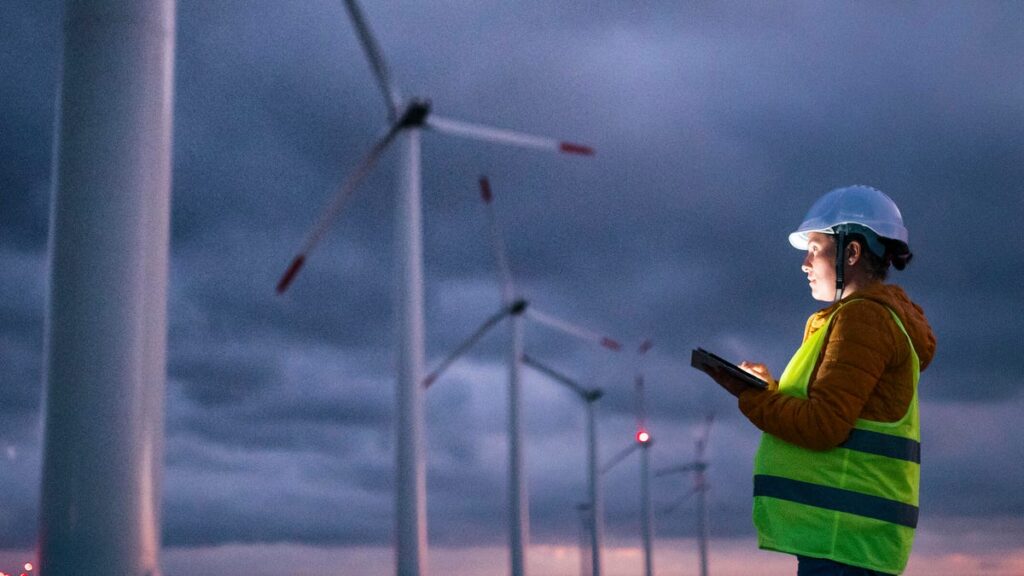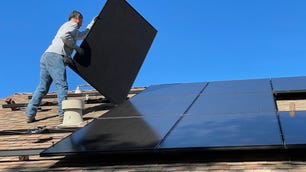More than 40 years ago, President Jimmy Carter installed solar panels on the roof of the White House. In his speech unveiling the panels, Carter warned that the technology could become “a curiosity, a museum piece, an example of a road not taken” or, he optimistically said, “harnessing the power of the sun, became a defining moment for this country”. Enriching our lives as we move away from heavy dependence on foreign oil. ”
With the rapid development of solar energy in recent years, the technology has certainly become more than a curiosity. It’s starting to deliver on its promise of clean, cheap, plentiful power.
“When Carter installed solar panels on the White House, it was a moment, but solar panels are very expensive. It’s a symbol of what it represents. It’s not an economic decision,” said Fourth Dynamics CEO Arvin Ganesan. Arvin Ganesan, an energy storage manufacturer. “What’s happened since then is that the cost of renewable energy is now the cheapest way to generate new electrons on the grid.”
While renewable energy is now a cheaper way to generate electricity than climate-warming fossil fuels, your electricity bill may still be rising. So what causes this, and when will the tide turn?
Electricity costs continue to rise
Converting solar energy into electricity is fairly cheap. But when the electricity bill comes, people don’t feel like energy is cheap.
According to the U.S. Bureau of Labor Statistics, average electricity bills increased by nearly 3% between February 2023 and February 2024. This increase is not universal and depends on the state because of vast differences in policy and economic factors. North Carolina, for example, had the largest increase during this period, at 17%, while New Hampshire saw costs fall by 17.7%.
These costs are significant. The National Energy Assistance Directors Association and the Center on Energy Poverty and Climate predict that home cooling costs will increase 7.9% from last year, due in large part to rising temperatures.
At the same time, we are harvesting more clean electricity than ever before. In 2023, U.S. solar power generation will be 238 terawatt hours, eight times the amount generated a decade ago.
The problem is: we still don’t have enough cheap renewable energy. About 60% of U.S. electricity still comes from fossil fuels, with 43% coming from natural gas, according to the U.S. Energy Information Administration.
That means much of the grid is vulnerable to oil price fluctuations, which can be affected by global wars, weather events and other disruptions.
At the same time, the portion of our electricity that comes from renewable sources has been getting cheaper. In 2022, a report from the International Renewable Energy Agency found that global wind and solar power generation costs fell by 13% or more.
“Renewable energy is by far the cheapest form of electricity,” IRENA Director General Francesco La Camera said in the report. “2022 is a clear example of how economically viable new renewable energy generation is becoming. Renewable energy Insulate the economy from volatile fossil fuel prices and imports, curb energy costs and strengthen market resilience – especially if today’s energy crunch continues.
Ganesan, whose company develops thermal battery technology, believes the evolution of technology has brought us to this point.
“The efficiency of solar panels is much better now,” he said. “The output efficiency of solar panels is now very high. The reason for this is that the government has promoted many projects in the past 20 years to reduce the cost of renewable energy. So it is the government’s R&D and intervention that triggered this revolution that will Low-cost, high-efficiency solar panels are coming to market, as is wind energy.
Who should pay for the energy transition?
Despite the shift to cheaper, cleaner renewable energy, consumers still don’t give the energy system high marks. A recent report from global accounting and advisory firm Ernst & Young details declining confidence in the energy system and consumers’ sense of responsibility as individuals to make changes. Instead, Americans believe the burden of the energy transition should fall more heavily on the energy industry.
A survey of 3,000 U.S. consumers found that only 30% of Americans are “confident that their energy prices will remain affordable,” with “consumer confidence in the U.S. energy system” declining from 65.8% in 2022 to 56.9%. Clean energy.
The report’s lead author Greg Guthridge, EY’s global energy and resources customer experience transformation leader, said he was not shocked by the findings. “The gap is so big, that’s what we expected to see,” he said. “The early adopters have already moved, now we need to find a way to activate those who are currently unable or unwilling to move, through the energy transition.”
Chris Ventura, executive director of the Consumer Association of America’s Midwest chapter, said even those who are ready to switch to clean energy don’t necessarily have the ability to do so, making it more challenging for consumers to drive the market. . While programs like community solar and solar for all aim to expand access to solar power beyond rooftop solar systems, not everyone has access to them.
“For most people, it’s going to take some time,” Ventura said. “Unlike the iPhone, no matter where you live, if you like renewable energy and want to put solar panels on your roof, you can do that if you own your home. But if you’re a renter or live in In a multifamily unit or apartment, you don’t have those opportunities.
Like consumers surveyed by EY, Ganesan said there should be less demands on individuals and more emphasis on systemic changes to solve “systemic problems.”
“I definitely agree with the idea that people generally feel overburdened and don’t want this to fall on their shoulders,” he said. “One in five people in the United States can’t pay their electric bill, so solutions will It’s unfair to fall entirely on their shoulders, especially when governments and utility companies are already ready to provide solutions.”
When will renewable energy lower energy prices?
In an industry that is playing catch-up with technology, demand and infrastructure, when will consumers see a difference in energy costs? Experts hope we’re not far off, and they’re looking good.
“Simply put, if it’s cheaper to build new renewables plus storage (capital expenditures) than… to build new natural gas power plants plus fuel costs, then you’re going to build clean energy every time,” Ganesan said. Cost reductions ultimately lead to cost savings for consumers, and we’re at that inflection point now.”
One factor affecting clean energy is the upfront cost. From solar panel installations to electric vehicles, the promise of return on investment can be a hard sell. But as technology advances, upfront costs decrease and sales become easier.
Albert Gore, executive director of the Zero Emission Transportation Association and son of former Vice President Al Gore, said investing in renewable energy “sounds too good to be true.” “And, in terms of a solar system, it does require the ability to invest $30,000 knowing that you might break even in eight years, depending on where you live. But public sentiment has improved significantly.”
As with all these uses of electricity, one thing is for sure: stability is a good thing. Whether you’re charging your electric car or powering your home, it’s easier to rely on the wind and the sun than to harvest fossil fuels and ship them around the world.
“Renewables combined with other technologies … have the potential to help stabilize the grid over the long term, thereby reducing costs,” said Ben Prochazka, executive director of the nonpartisan nonprofit Electrification Alliance. “That’s where the costs come from: unstable energy and instability needs.”


